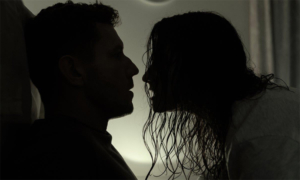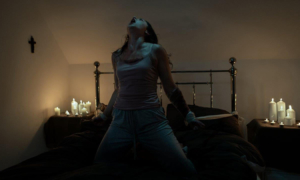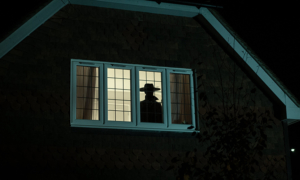New supernatural horror The Last Rite follows Lucy (Bethan Waller), a medical student suffering from sleep paralysis, after moving in with her boyfriend, Ben (Johnny Fleming). Soon, she finds herself plagued by a demonic entity – the terrifying Man In The Hat – who is hell-bent on ripping her apart. With time running out and the dark force consuming her from within, Lucy is left with no alternative but to seek help from a local priest, But Father Roberts has a dilemma – does he obey orders or help Lucy by conducting his own exorcism against the will of the church?
We spoke to The Last Rite writer and director Leroy Kincaide about how the movie is actually inspired by his own experience with sleep paralysis and why we just can’t resist an exorcism movie…
When did you first get the idea for The Last Rite?
Quite randomly! I was out in Colombia doing a bit of work and I had some downtime and I just had this idea of this folklore thing that I remember hearing about with a guy in a hat. A Shadow Man-type of figure.
I had this really random image of a guy standing in silhouette in a fedora hat and it stayed with me for a few weeks. Then I was like, ‘okay, well, I’ve had some experience with sleep paralysis… maybe I do a story on something like this’.
I didn’t know I was going to do a feature to be fair. I just had this idea! Then my partner, Chloe, who is the producer, and I just said, ‘well, maybe we’ll just do our first feature with this new idea!’.
I had the idea probably in September 2018 and I had the first draft of the script by November of that year and here we are!

Where did you go from there after that initial idea?
The first is you have to look at are the areas of the story that you’re ultimately serving. One was definitely the sleep paralysis. I have some first-hand experience from that, so there wasn’t an awful lot that I needed to do. Even though curiosity-wise, I’d done loads of research well before doing this.
Shadow Figures was another area. There are case studies and different stories that other people have had because no one shoe fits all. A lot of people have had similar experiences and different experiences.
The other main area was demonic possession. You’ve got the three stages of demonic possession. To serve that area really well, it’s not really about watching movies at that stage, it’s about looking at what happens in an oppressive state. Why are there certain arguments that take place in and around people that say they’re being possessed? There’s a gradual degradation of a person’s psyche and it’s more the psychological impact that I found very interesting.
I went to a couple of churches, spoke to two priests and it was just really interesting. You’d be very surprised actually – they’re quite standoffish about that sort of thing though, believe it or not!
It’s really interesting because if there’s nothing in it, why have a whole chain of command in how you go about organising an exorcism? But it’s not actually an exorcism. It’s called ‘deliverance ministry’. So to do a deliverance ministry, the Archbishop has to get involved, a Chancellor or someone has to go to the Archbishop. And it can’t just be any random person that does it. It’s really interesting that there’s this entire process and chain of command behind something that people might perceive as fictitious. Even the Vatican’s got a whole area dedicated to the study of demonology. It’s fascinating stuff.
Speaking of which, what is it about exorcism and demonology movies that really pull audiences in?
I think it’s the curiosity of the unknown. I think we all know someone who has spoken about an old ghost story. People have accounts of seeing ghosts, and if you can see a ghost, then being possessed could maybe be a thing.
I think what’s curious about people’s nature, when it comes to ghosts and when it comes to the supernatural, is that nobody really knows what to say or think about it. No one can disprove or prove it. The only thing you have is the account that someone had and the lasting impression it leaves on the life.
I think this is something that people find quite fascinating. It’s almost like being around a campfire, burning marshmallows and talking about ghost stories. I think everyone’s intrigued by those sorts of stories. The Last Rite for me was a film that I wanted to fit inside of a space that wasn’t trying to do the Hollywood jump scare upon jump scare effect. It was actually looking at how somebody has become affected, and then when they’re affected, how does it break them down in their psyche and personality? It’s a fascinating subject, I absolutely love it.

Now… we have to talk about The Man In The Hat. How did you settle on the look for him?
The Man in the Hat was partly inspired by one I had heard of before, but also more so to do with my experience with sleep paralysis.
What I can remember from when I had my experiences was a very dark figure. It was just present. It doesn’t move. It’s not about them chasing you up the stairs and making you scared. To wake up not being able to move and have something present in the room is a terrifying enough experience!
What I wanted to do was to have this shape of this man in a hat, but not really show this man in the hat. I was very conscious of not trying to go ‘oh, here’s the bad guy. Let me show you that’. It is actually not quite in focus. It’s like this in-between thing. It’s just a presence.
There are variations of different experiences of sleep paralysis. I’ve had two. But when you have them, it’s not actually what you see, it’s the presence and the after effect of the feeling that you’re left with. What I wanted to do in the story was look at this presence.
With the look, it was just literally a hat, jacket, and facemask to cover the skin and then we had our look! It was relatively simple. It was just a case of just thinking outside of the box a tiny bit with how we showed it.

Why did you decide to set The Last Rite in a modern house rather than a typically gothic-looking house?
Budget! I’m not going to lie in the slightest haha!
The budget constraints were like trying to get a square peg in a round hole. It was like ‘well this is the house we can afford’ and it works for the best part of the story. The type of setting I ideally wanted would have been something with a little bit more character to it, so instead I had to integrate part of the house’s personality into one of the characters. Ben is an art dealer and he’s got all of these random collections of art up on the walls, so I tried to make elements of that a part of the aesthetic.
In a weird way, I’m probably quite thankful it played out in that type of environment. The modern feel wasn’t a purposeful intention but in the end it does lend itself very well to that modern feel. Not everyone can relate to living in a manor house or an old country house or cottage, so it feels somewhat relatively close to someone’s house. It allows an audience a perspective of going ‘well, it doesn’t feel like it’s a million miles away from where I would live’.
What do you want for audiences to take away from The Last Rite?
I’m glad you asked that one! Weirdly, the entire film is about the ending. It’s not about answering questions, it’s about allowing the audience to ask a question. There’s some text at the end of the movie and that’s really what the movie is about.
It’s really about placing the space for an audience to ask a question and go ‘what if this does, can, and has really happened to people, someone I know, or me?’. It’s really about that because if people were inspired to go to Google, after they’ve watched the film, and just type in any of the elements – Shadow Man, demonic possession, sleep paralysis – they might be quite surprised by how well documented some of it is…
The Last Rite is out now on digital download.
